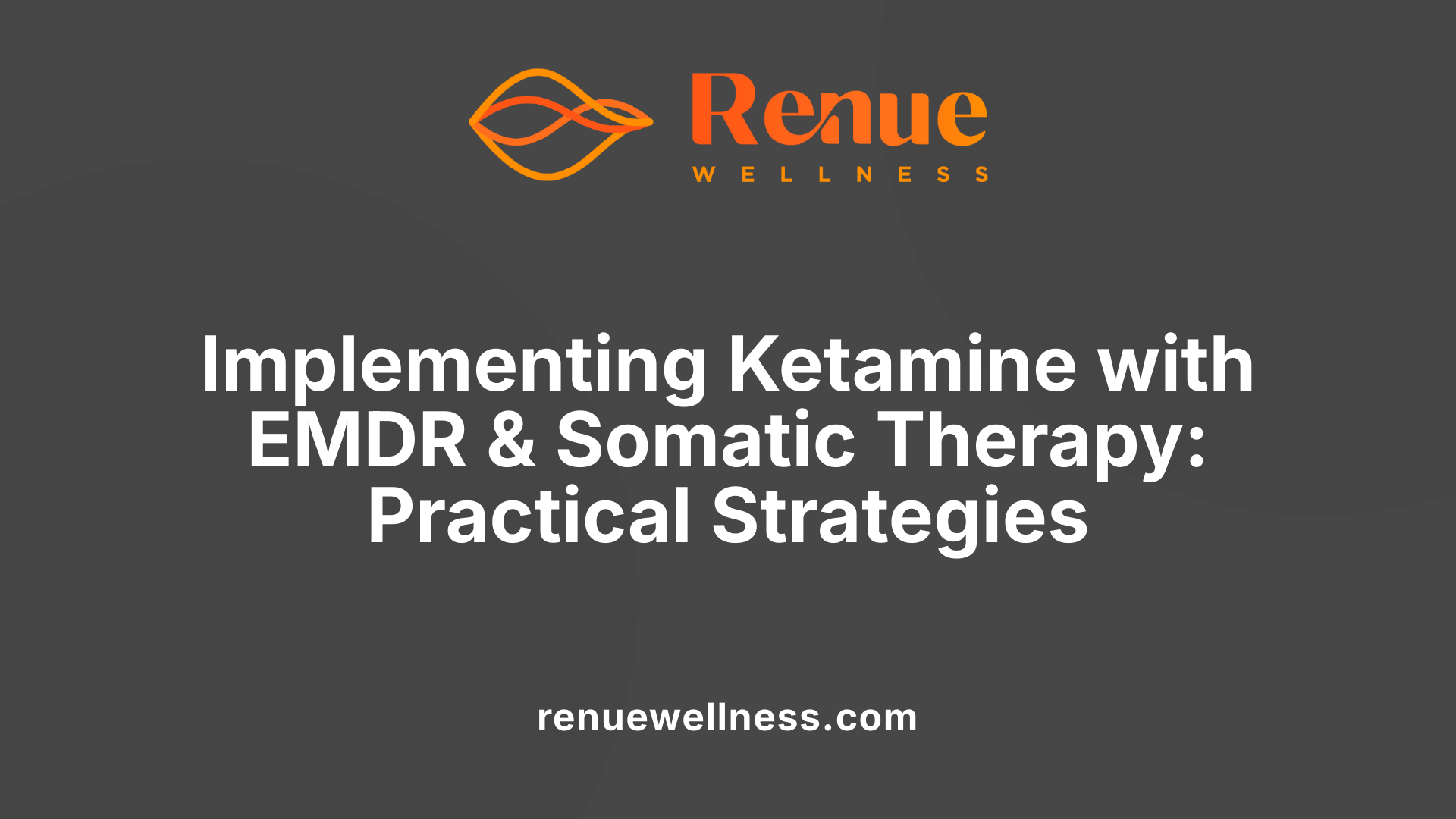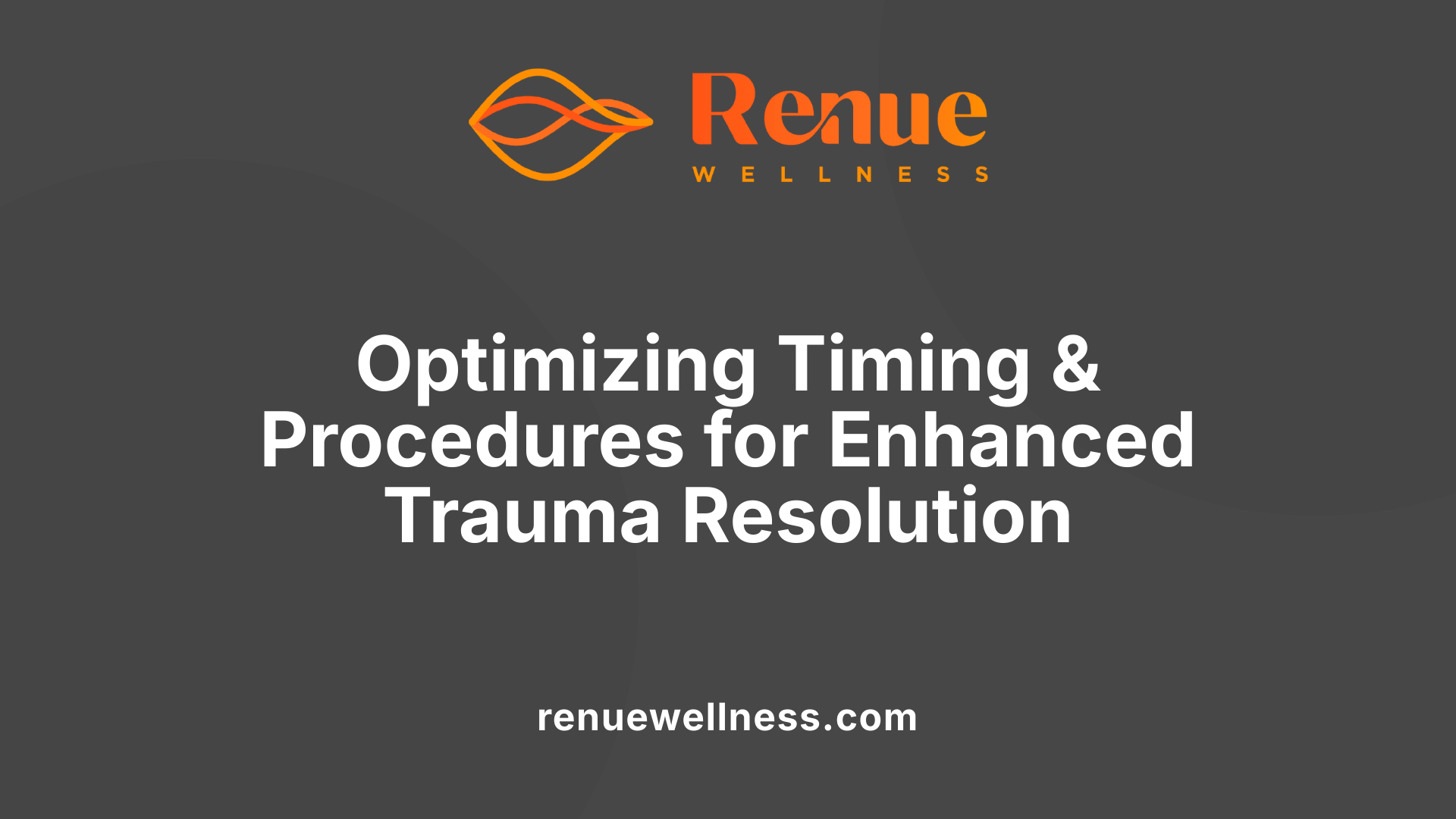Integrating Ketamine With EMDR or Somatic Therapy: A Guide


July 18, 2025
The Future of Trauma Recovery: Combining Pharmacology with Body-Centered Therapies
As mental health practitioners seek more effective methods to treat trauma, the integration of ketamine with EMDR and somatic therapy emerges as a groundbreaking approach. This combination leverages neuroplasticity, bodily awareness, and evidence-based trauma processing techniques to facilitate profound and lasting healing. This guide explores the theoretical foundations, practical strategies, and therapeutic benefits of merging these modalities, offering clinicians and clients a comprehensive pathway to resolution.
Understanding the Foundations of Integrative Trauma Therapy
What is the scientific rationale and evidence supporting the integration of ketamine with EMDR or somatic therapy?
The integration of ketamine with therapies like EMDR (Eye Movement Desensitization and Reprocessing) and somatic approaches is rooted in a strong scientific basis that centers on ketamine’s effects on the brain, nervous system, and trauma processing mechanisms.
Ketamine’s primary action involves enhancing neuroplasticity—the brain’s ability to reorganize, form new connections, and adapt. This is particularly important for trauma therapy, as it allows clients to rewire maladaptive emotional and cognitive pathways that sustain trauma symptoms.
Research shows that ketamine facilitates rapid symptom relief in conditions such as PTSD, depression, and anxiety by disrupting dysfunctional neural circuits. Studies demonstrate that ketamine increases levels of Brain-Derived Neurotrophic Factor (BDNF), a protein vital for promoting growth of new neurons and synapses. This neurogenesis supports a more flexible brain environment, ideal for therapeutic work.
One of ketamine’s notable effects is its ability to temporarily reduce activity in the Default Mode Network (DMN)—a network associated with self-referential thought, rumination, and negative thinking. By dampening DMN activity, ketamine creates a dissociative or detached state, freeing clients from their usual mental filters and defenses. This detachment enhances their capacity to access traumatic memories and emotional material that might be blocked or avoided during traditional therapy.
Furthermore, ketamine’s action on glutamate pathways contributes to improved communication across different brain regions. This increased neural connectivity supports the integration of body-mind approaches like EMDR and somatic therapy, which rely on engaging both mental and physical sensations to process trauma.
Clinical evidence supports the use of ketamine as an adjunct in trauma treatment. Pilot studies and clinical reports indicate that combining ketamine with EMDR accelerates trauma resolution, especially in clients with dissociative tendencies or complex PTSD. The rapid neuroplasticity effects of ketamine help unmask suppressed memories, allowing EMDR techniques such as bilateral stimulation to more effectively facilitate processing, reorganization, and emotional integration.
Similarly, somatic therapies benefit from ketamine’s ability to release physical tension and involve the body directly in trauma processing. When clients experience ketamine-induced dissociation, they often become more aware of bodily sensations and energy, which can be harnessed to address physical manifestations of trauma.
While promising, ongoing research continues to explore and refine this integrated approach, emphasizing the importance of careful client selection, safety, and tailored treatment protocols. Nonetheless, the convergence of neurochemical, physiological, and psychological mechanisms offers a compelling scientific rationale for combining ketamine with EMDR and somatic therapies in trauma recovery.
| Aspect | Effect | Relevance |
|---|---|---|
| Neuroplasticity | Increased BDNF and synaptogenesis | Supports brain rewiring and new learning |
| Default Mode Network | Reduced activity | Less rumination, greater psychological distance from trauma |
| Neural Connectivity | Enhanced cross-region communication | Facilitates integrated processing of thoughts, feelings, and body sensations |
| Dissociation | Transient detachment | Allows access to difficult memories safely |
| Emotional Learning | Facilitated by neurochemical changes | Promotes new emotional associations and beliefs |
This integrated approach—leveraging ketamine’s neurobiological effects with EMDR and somatic therapies—aims to deliver faster, deeper, and more sustainable healing for trauma survivors.
Practical Techniques and Best Practices for Integrative Treatment

How can ketamine be integrated with EMDR or somatic therapy in clinical practice?
Integrating ketamine with EMDR or somatic therapy requires careful timing and tailored protocols to optimize healing. Clinicians typically schedule trauma-focused sessions within a specific window after ketamine administration, usually between 24 to 48 hours. This period leverages the heightened neuroplasticity induced by ketamine, making the brain more receptive to processing and reorganization.
Preparation is crucial. Therapists conduct thorough psychoeducation to inform clients about how ketamine and therapy will work together. Setting clear intentions and establishing safety protocols help clients feel secure and supported during their journeys. This groundwork enhances the therapeutic alliance and readiness for processing deep-seated trauma.
During therapy sessions, adaptations of EMDR are essential to accommodate altered states. Therapists monitor dissociation levels and manage abreactions carefully, using techniques like resource development and titration to prevent overwhelm. In somatic approaches, practices such as massage, Reiki, or body awareness exercises are employed during and immediately after ketamine sessions. These modalities facilitate bodily relaxation, release residual tension, and deepen emotional processing.
Post-session routines are equally important. Activities like gentle movement, journaling, mindfulness, and sensory grounding are recommended to reinforce insights and promote integration. Clients often find that engaging in these practices helps solidify emotional releases and facilitates sustained change.
Through strategic timing, personalized protocols, and a focus on bodily awareness, clinicians can harness the synergistic effects of ketamine, EMDR, and somatic therapies. This integrated approach promotes profound trauma resolution, leading to long-term emotional resilience and well-being.
Supporting Strategies and Adjunct Practices to Maximize Outcomes

What support strategies and adjunct practices can enhance the outcomes of combined ketamine and trauma-focused therapies?
Integrating ketamine-assisted psychotherapy with trauma processing modalities like EMDR or somatic therapies requires a thoughtful combination of support strategies and complementary practices. These strategies aim to create a safe, nurturing environment and foster lasting change.
Pre-treatment assessments are crucial. They include thorough medical and psychological evaluations to confirm suitability and reduce risks. This preparatory step ensures clients are physically and emotionally ready for the therapy, helping to build trust and safety from the outset.
During sessions, continuous supervision by trained professionals maintains safety. Monitoring vital signs such as heart rate and blood pressure, along with psychological cues, allows clinicians to adjust dosing and support as needed, preventing adverse reactions. Clear communication about the process enhances trust, while grounding techniques and environment setup—like calming music and comfortable settings—further support clients.
Post-treatment, ongoing integration is vital to consolidate insights and neuroplastic gains. Practices such as journaling individual thoughts, emotional states, sensory experiences, and bodily sensations help process and record changes. Art therapy and creative expression tapping into the neuroplastic window created by ketamine enable visual and embodied processing of complex emotions.
Mindfulness and gentle movement, including yoga or walking, aid in physical and emotional regulation and serve as embodied anchors for therapeutic insights. These practices help clients stay connected to their bodies and nervous systems, promoting resilience.
Establishing community and peer support networks significantly enhances emotional resilience. Sharing experiences with trusted others diminishes feelings of isolation, normalizes emotional reactions, and fosters mutual encouragement, all of which are essential for long-term recovery.
Lifestyle factors also play an important role. Maintaining proper nutrition—including balanced, whole foods and hydration—supports brain and body healing. Prioritizing sleep hygiene, such as avoiding screens before bed, keeping bedrooms cool and dark, and sticking to consistent sleep routines, supports memory consolidation and emotional regulation.
Physical activity, like walking, dancing, or yoga, not only boosts mood but also encourages neuroplasticity. These activities are accessible, low-cost, and can be integrated easily into daily routines.
Holistic, personalized support extends beyond immediate therapy sessions. Continual access to mental health professionals for follow-up care ensures ongoing safety and guidance. Combining therapy with self-care routines nurtures a comprehensive approach to healing.
In essence, these support mechanisms create a multi-layered framework that amplifies therapeutic effects, stabilizes progress, and fosters sustainable healing. When tailored to individual needs, they transform therapy from isolated sessions into a continuous journey of growth.
| Support Components | Specific Practices | Purpose | Additional Notes |
|---|---|---|---|
| Pre-treatment assessments | Medical & psychological evaluations | Risk reduction, readiness | Ensures safety and trust |
| In-session monitoring | Vital signs, psychological cues | Safety, dose adjustment | Maintained by trained clinicians |
| Post-session integration | Journaling, art therapy, mindfulness | Processing insights | Reinforces neuroplasticity |
| Physical movement & body work | Yoga, walking, somatic exercises | Emotional regulation, body awareness | Supports nervous system regulation |
| Community & peer support | Support groups, shared experiences | Resilience, normalization | Reduces isolation |
| Lifestyle practices | Nutrition, sleep hygiene, hydration | Overall health, healing | Facilitates neuroplasticity |
| Ongoing professional support | Follow-up therapy, supervision | Long-term stability | Personalized care enhances results |
By combining these strategies with evidence-based therapies, practitioners can significantly enhance the therapeutic experience. Clients are better equipped to process complex trauma, maintain emotional stability, and integrate their healing into everyday life, ensuring that the benefits of ketamine and trauma-focused therapies are long-lasting.
Timing and Procedural Considerations in Combined Therapies

What processes, procedures, and timing considerations are involved in combining ketamine with EMDR or somatic therapy?
Combining ketamine with trauma-focused therapies like EMDR or somatic therapy requires careful planning and precise timing to optimize therapeutic outcomes. The typical approach involves administering ketamine 24 to 48 hours before engaging in trauma processing sessions. This timing leverages the heightened neuroplasticity that ketamine induces, creating an optimal state for accelerating emotional and somatic resolution.
Preparation steps begin well before dosing. Clients undergo comprehensive medical and psychological assessments to ensure safety and suitability for ketamine therapy. Education about what to expect during and after sessions is essential, emphasizing safety protocols such as avoiding alcohol, recreational drugs, and overstimulation. Clients are also guided to develop strong somatic resources—like tracking bodily sensations and nervous system regulation—to facilitate integration.
During the ketamine session, multiple safety measures are in place. These include careful dosage control, monitoring physical responses such as heart rate and blood pressure, and observing psychological cues. Clients may experience dissociative effects, which can help lower defenses and increase openness during subsequent trauma work.
Following the ketamine session, a structured debriefing period supports emotional stabilization. Integration activities—such as journaling, mindfulness, and gentle movement—are incorporated to help process insights. The trauma therapy, whether EMDR or somatic work, then takes place within this window, allowing clients to revisit and reprocess memories with reduced resistance.
The collaboration among experienced clinicians—psychologists, psychiatrists, and somatic therapists—is critical to ensure procedural integrity. They work together to carefully sequence sessions, adjusting timing and responses based on individual needs. This coordinated approach ensures the neuroplastic state created by ketamine is effectively utilized for trauma resolution.
In summary, the process involves several stages: pre-session preparation, timed ketamine dosing, real-time monitoring, trauma therapy within the neuroplastic window, and post-session integration. This strategic sequencing maximizes the potential for deep healing, addressing complex trauma safely and efficiently.
Client Preparation and Post-Treatment Support Strategies

How should practitioners prepare clients for combined ketamine and EMDR or somatic therapy, and what aftercare strategies are recommended?
Effective preparation and aftercare are crucial when integrating ketamine-assisted psychotherapy with EMDR or somatic approaches. Before the session, practitioners emphasize comprehensive psychoeducation, clearly explaining each step of the process. Clients are guided to set intentions, such as openness to emotional exploration and trust in the healing journey. Medical clearance is obtained to confirm safety, and clients are advised to avoid substances like alcohol, heavy foods, and overstimulating activities beforehand.
Preparation also involves creating a safe environment by encouraging hydration, light nutritious meals, and planning for sufficient rest after sessions. Clients are introduced to grounding strategies and somatic resource development, such as bodily awareness exercises, to enhance their capacity to stay present during the dissociative states induced by ketamine.
Post-session, a structured routine supports integration. Clients are encouraged to engage in practices like journaling to record insights, mindful reflection, and gentle movement such as yoga or walking to help physicalize and process emotional experiences. Somatic practices like deep breathing or body scans help reinforce nervous system regulation.
Follow-up therapy sessions are essential for ongoing processing, especially to address unresolved emotions or memories that surface during ketamine experiences. These sessions often incorporate EMDR or somatic techniques to deepen trauma resolution and emotional resilience.
Creating a supportive community environment, whether through peer groups or support networks, fosters feelings of safety and understanding. Providing accessible resources and psychoeducational materials empowers clients to continue their healing outside the therapy room.
Overall, these strategies—covering preparation, within-session safety, and post-session routines—maximize the therapeutic potential of combined ketamine and trauma-focused therapies. They enhance neuroplasticity, promote emotional integration, and facilitate lasting transformational change.
Trauma Processing, Safety, and the Role of Protocols
Are there clinical protocols or approaches for trauma processing that combine ketamine with EMDR or somatic therapy?
The integration of ketamine with trauma-focused therapies such as EMDR and somatic therapies is a promising area that is still developing. While comprehensive, standardized protocols are not yet universally established, clinicians are creating tailored approaches based on existing research, clinical experience, and emerging best practices.
Typically, these approaches involve carefully timed sessions where ketamine infusions are administered in conjunction with or immediately prior to trauma processing work. This timing aims to leverage the neuroplastic state induced by ketamine, making the brain more receptive to reprocessing traumatic memories.
The structure of these combined therapies often follows principles similar to EMDR’s eight phases:
- Preparation: Building client stability, resources, and modulation skills.
- Assessment: Identifying target memories or bodily sensations significant to trauma.
- Desensitization: Using bilateral stimulation (like eye movements or tactile cues) during the ketamine state.
- Installation and Body Scan: Reinforcing positive cognition and checking for physical or emotional residual tension.
- Re-evaluation and Closure: Ensuring client stability before concluding.
Practitioners emphasize safety, stabilization, and gradual exposure, with scheduled breaks and monitoring between ketamine sessions. They adapt protocols to individual needs, factoring in clients' trauma history, dissociative tendencies, and physiological responses.
Monitoring during ketamine sessions includes assessing vital signs (heart rate, blood pressure) and psychological cues to maintain safety. Therapeutic rapport and a calm environment are essential, along with contingency plans for managing adverse reactions or intense emotional releases.
As this field evolves, ongoing research and pilot studies inform the emergence of more standardized protocols. These focus on maximizing therapeutic benefits while prioritizing safety and client-centered care, promising a future where combined ketamine and trauma therapy frameworks are more widely accessible.
In summary, while formal protocols are still being refined, current approaches involve a combination of preparatory stabilization, timing of ketamine delivery with trauma reprocessing, real-time assessment, and post-session integration — all within a holistic, flexible, and safety-conscious framework.
Pathways to Sustainable Healing
The integration of ketamine with EMDR and somatic therapy heralds a new epoch in trauma treatment. By blending pharmacological neuroplasticity with body-based and trauma-focused techniques, practitioners can facilitate rapid, profound healing that addresses both mind and body. Success hinges on careful timing, thorough preparation, ongoing support, and a solid understanding of the underlying neuroscience. As research progresses and protocols become more standardized, this innovative approach promises a future where trauma can be understood and treated holistically—empowering individuals to reclaim resilience, wellness, and long-term recovery.
References
- EMDR & Ketamine Integration: A Path to Deep Healing
- Integrating Ketamine for Somatic Therapy: A How-To Guide
- EMDR Therapy and Ketamine-Assisted Therapy - Sona Collective
- Between Ketamine Infusion Therapy Sessions: Guidance from the ...
- A Guide to Ketamine-Assisted Therapy Sessions - Mind Body Seven
- EMDR Therapy and Psychedelics - EMDRIA
- Integrating Somatic Experiencing in Ketamine-Assisted Therapy
- Ketamine Therapy and Holistic Healing in Integrative Psychiatry
- Somatic EMDR: 5 Ways It Heals Complex Trauma | 2025 Guide
Recent Posts
Conditions Treated
AnxietyDepressionOCDPTSDPostpartum DepressionPain ManagementSubstance AbuseSuicidal IdeationOur Location


